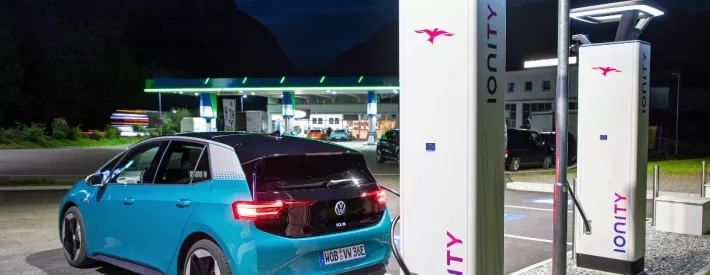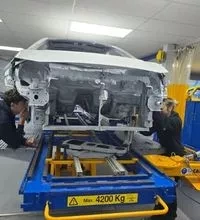The road to green travel: Where are we going?

Electric vehicle sales are on the up and a recent report by Volkswagen Services UK highlights the growing appetite for EVs, whether it’s passenger or light commercial vehicles.
But while vehicle sales grow, there are still challenges that need to be addressed; infrastructure is top of the list.
So, what has VW learned from its latest quarterly EV Tracker Report?
The EV adoption curve
The positive momentum seen in the first EV tracker report, as consumers and businesses make the switch to more environmentally friendly transport solutions, continues.
According to the latest statistics from the DfT, more battery electric cars (64,000) were registered for the first time in the UK during Q1 2022 (January to March) than diesel cars (34,000), following a 102% annual increase in BEV cars compared to Q1 2021.
By contrast, over the same period, there were falls of 11% and 52% for petrol and diesel cars respectively, whilst average CO2 emissions for cars registered for the first time in the UK decreased by 13% in Q1 2022 versus Q1 2021.
Even more up-to-date figures from the SMMT show that BEVs continued their growth streak in June, with a 14.6% increase in volume, as market share continued to grow, reaching 16.1%, up from 10.7% a year before. Over the same period, diesel and petrol vehicles fell 46.7% and 28.2% respectively.
The Climate Change Committee has set out an EV adoption curve until 2032. Data compiled by Volkswagen Financial Services UK shows that the UK is 101,840 EVs ahead of the curve.
At the end of March 2022, there were 833,000 licensed ultra-low emission vehicles in the UK – the equivalent of 1 in 50 of all vehicles on UK roads. To put this market dynamic acceleration into context, this was an increase of 71% compared to the end of March 2021.
These numbers depict a steeper-than-needed adoption rate, which is to be welcomed if the Climate Change Committee’s ultimate target of 55% of all light duty vehicles being battery powered by 2032 is to be met.
The public charging infrastructure challenge
While EV sales continue to experience excellent levels of growth, it contrasts with ongoing concerns about the public charging infrastructure needed to support the mass move to sustainable transport.
Increasingly, would-be EV purchasers are expressing reluctance to switch until they have confidence that an adequate charging infrastructure is in place in the UK. Currently, only 24% of consumers are confident that sufficient charging infrastructure is in place to support wider adoption of electric vehicles.
The Competition and Markets Authority suggests that the UK will need 480,000 public charging points by 2030. But current progress remains slow.
In the year to July 2022, just 7,637 additional charging points were installed, bringing the overall total across the UK to 32,011. The European Commission recommends a ratio of one charger per every 10 EVs.
However, we know from OZEV EV Grant data that approximately 300,000 home charge-points have been installed across the UK and a further circa 200,000 workplace chargers have been fitted as part of the Workplace Charging Scheme.
Therefore, the conundrum of a lack of public charge points is a common misconception. The bigger issue is ensuring that the nation’s public charging network becomes more accessible.
For example, that public charge-points are easily compatible with a uniform contactless payment method, are reliable and deliver the advertised power (particularly relevant for ultra-rapid chargers); a potential solution could see providers bound by industry standard SLAs regulated by Ofgem. Clearly, charge points must also be evenly spread in sufficient numbers across the UK.
Where public charging installation has occurred, a postcode lottery remains in place. Based on public charging points per 100,000 people London (116), Scotland (55), the South East (44) and the South West (39) continue to see the highest level of charging points, whilst Yorkshire and the Humber (29), the North West (27) and Northern Ireland (17) show the lowest level.
However, the positive news is that between April and June 2022, all regions across the UK, apart from Northern Ireland, saw an increase in total charging devices. The North East had the greatest increase at 14.2%, whilst London had the greatest increase in absolute number of devices at 462 devices, contributing to 27% of the increase in devices across the UK in this period.
Interestingly, Scotland has the highest rate of rapid device provision of 14.2 rapid devices per 100,000, with the average provision in the UK being 8.9 per 100,000. It is no coincidence that adoption of EVs is happening more quickly across the South of England, where charging infrastructure enhancements are taking place at a far swifter rate than other areas of the UK.
Such inequality needs to be addressed without delay to ensure that the EV adoption rate is both maintained and distributed more equally across the whole of the nation.
Growing electric LCV numbers
Reflecting the positive progress of EV car adoption, figures for eLCV also shows tangible promise. As of March 2022, the UK eLCV fleet size stood at 32,000, accounting for 4% of the UK’s licensed plug-in vehicles.
It’s predicted that this growth momentum will continue through 2022 as more vans are launched, with new options from both Volkswagen and Ford, among others. This delivers increased choice to businesses looking for greener transport options. It also removes the time and resources needed to retrofit and alter existing petrol and diesel powered LCVs which has been the preferred route for many business owners until now, and who have been put off by eLCV choice, availability, and cost.




